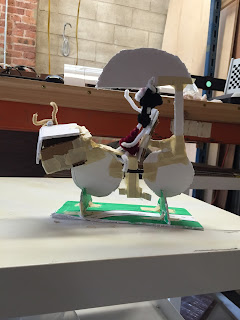In the last unit of the Design and Engineering course, we talked about bikes and how they work. We talked about the way they are made and the different types of bikes there are in the world. We got to go to a bike shop and actually learn about all the different types of bikes that there are and how they are used and how each bike is different. For this action project we were given a persona to create a bike for. We were told how far they had to travel, what kind of terrain they would be in, and what their needs were. I am proud of the way that my bike came out. The bike we created looks exactly like how I wanted it to look and I think that it fits all of our persona’s needs. One obstacle we ran into was trying to figure out how to make the seat comfy with a back but at the same time making it so she could still pedal freely. We had to alter the seat a few times so that the pedals could still be reached. Another obstacle we had to overcome was while we were creating the bike. It was hard to make all of the things we wanted look the way we pictured.
Since our rider will be riding up and down a lot of hills on her way to and from school, she is going to have a lot of potential and kinetic energy. We realized that our bike has potential energy whenever it’s on top of the hill just waiting for her to continue down it. The bike has kinetic energy whenever she is actually traveling down or up hill because she is exerting her energy to get herself to the top and then using the energy she gathered to make herself actually go down the hill.
For our persona, we had a 13 year old girl named Christine. She had to travel 3 miles to school and she lived in Peterson Park. Since Chicago is known for its extremely unpredictable weather, we had to create a bike with little things that would help her in the harsh weather all year round. She was also very serious about comfort. She didn't want to have to waste all of her energy on her ride to school. In designing our bike, we mainly focused on how comfortable the bike was going to be. Our persona never mentioned needing some place to put her backpack but we figured since she was going to school, she might have heavy things to carry, so we created a basket in the front of her bike that would hold her backpack. We also created a waterproof sheet that can be put over the basket for when it rains or snows.
While we were figuring out how we wanted to make our bike, we had to do an interview with a biker that we knew. My cousin told me that he “hates having to travel up and down hills because since my bike is a fixed gear, it makes extremely bad noises when I am trying to travel uphill.” This made us realize that since our user is going to be having to travel up and down hills on her way to and from school, we could not make her bike a fixed gear single speed bike. We then had to think about our gear ratios. We decided to have our gear ratio be 1:2 so that for every 2 pedal rotation the wheel would turn 1 times. She really wanted an easy and comfortable ride so we had to make sure that the big cog was in the back and the small one was in the front. On the first gear there are 20 teeth and on the second gear there are 10. Our bike wheel has a diameter of 28in. It’s circumference is 87.92in. Christine is traveling 3 miles long. Google Maps says that it would take her around 20 minutes to get to school everyday. For our scale, 2.75 inches on our model is equal to 28 inches in real life. So, 1 inch on our model is equal to 10.18 inches in real life.
 |
| MF, 2015. Smoooth. |
 |
| MF, 2015. Smoooth. |
 |
| MF, 2015. Sketch. |
No comments:
Post a Comment